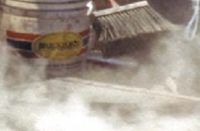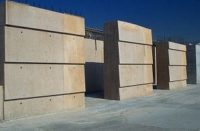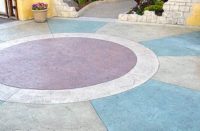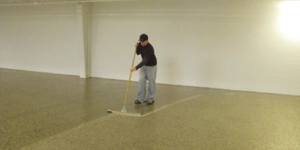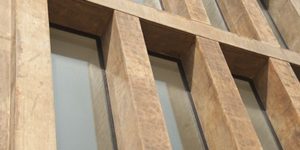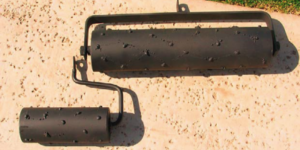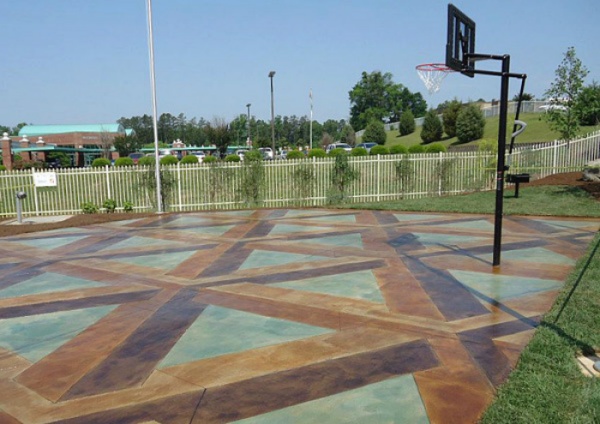
The acid-stained pizzeria floor looked worse than horrible. Actually, it became the unintentional focal point of an otherwise attractive restaurant newly opened and ready for business. I felt bad for the owner because I knew this gentleman had invested plenty of time and money expanding into a second location. There was no turning back — the auburn-colored mess was there to stay in all its ugly glory.
A bad stain job is an unnecessary part of life. The aforementioned project could just as easily been attractive, leaving every diner with a favorable introduction to stained concrete. This, unfortunately, was not the case.
A quality stain job is no accident. The combination of colored acid and concrete is an amazing medium, but only in the hands of someone prepared to make the proper effort of artistry.
Acid staining confuses too many so they shy themselves into a more expensive concrete staining process. The fact is, few products or procedures provide the colorful penetrating reaction of acid staining. Also, our industry offers few other products that provide the translucent colorful effect of acid staining.
There are only a few vital steps and procedures involved in every successful stain job. Each step layers over the previous step, compounding effort and skill into something extraordinary. There is little need to spend time and space on the importance of cleaning the concrete surface or providing on-site samples. Most readers realize this as necessary and assumed. The three steps and procedures I want to focus on go beyond such stained concrete basics.
Tip #1: Use appropriate dilution ratios for acid stain finishes
It is imperative to realize that all acid stain is sold condensed. It almost always requires dilution with water to create a more workable stain consistency. The darker the stain color, the more dilution required. Too much water and the chemical reaction will become compromised. Too little water and your project will look similar to the one in the pizzeria.
The necessary blend of water and stain is subjective. It could be a 1:1 blend or it could be three parts water for every one part stain. Remember, each concrete canvas is different, so the ratio of water to stain will be too.
The first stain application should favor a more diluted ratio, while the second application can be more condensed.
On-site stain samples offer the perfect opportunity to test multiple ratios of the same stain color. The more water, the lighter the stain color — nothing complex here. These samples provide the decision-maker with coloring options, but they also tell you, the installer, exactly how the concrete will react to each mixture of stain. The time for adjusting water-to-stain ratios is during the sample phase.
Tip #2: Back-spray
The most common distasteful effect found on acid-stained concrete is visible brush stroking. The thicker the stain consistency, the greater the likelihood of brush stroking. In return, lighter acid-stain colors decrease the likelihood of visible brush strokes. Water dilution reduces the likelihood of brush strokes too.
The risk of brush stroking is reduced, and sometimes completely eliminated, by back-spraying behind the brushing process with a light spray of acid stain. In other words, first spray your stain over a controlled area, then brush the stain into the concrete’s surface, and then lightly back-spray the area just brushed. This process allows the stain to disperse across the concrete surface without leaving patterns or stroking.
Tip #3: Use specially made sprayers
Fact: Not all plastic sprayers are conducive for acid staining, and far too many stain artists find this out the hard way. It is worth the money to buy a plastic sprayer made to spray acid stain. Sure, these sprayers cost more but they are designed specifically for applying acid to concrete. I personally use the Chapin Industrial 2-gallon Acid Staining sprayer. No doubt there are other good ones available, but this is my favorite. The large, 4-inch opening allows for quick, easy and spill-free filling every time. I paid just less than $70 for my Chapin acid sprayer and it’s worth twice the money, in my opinion.
Remember, a bad stain job is an accumulation of subpar steps and techniques. Investing in the proper sprayer eliminates one way to risk a less-than-stellar outcome. Considering all three issues just mentioned will put you and your decorative business miles ahead of the local competition.
